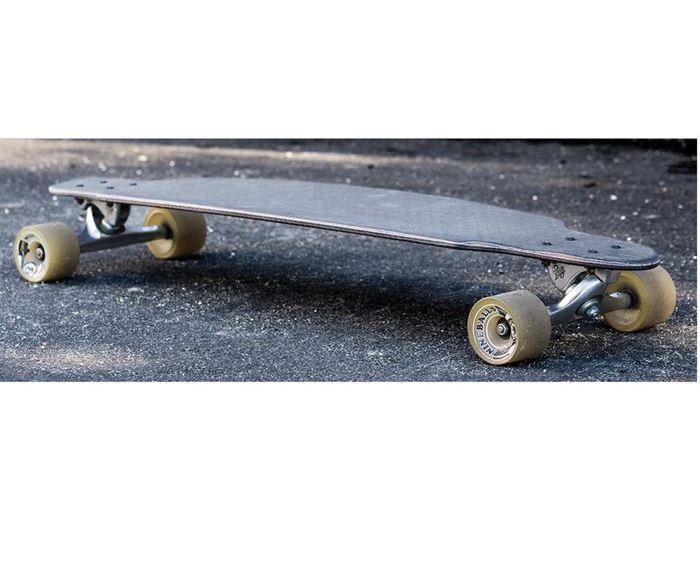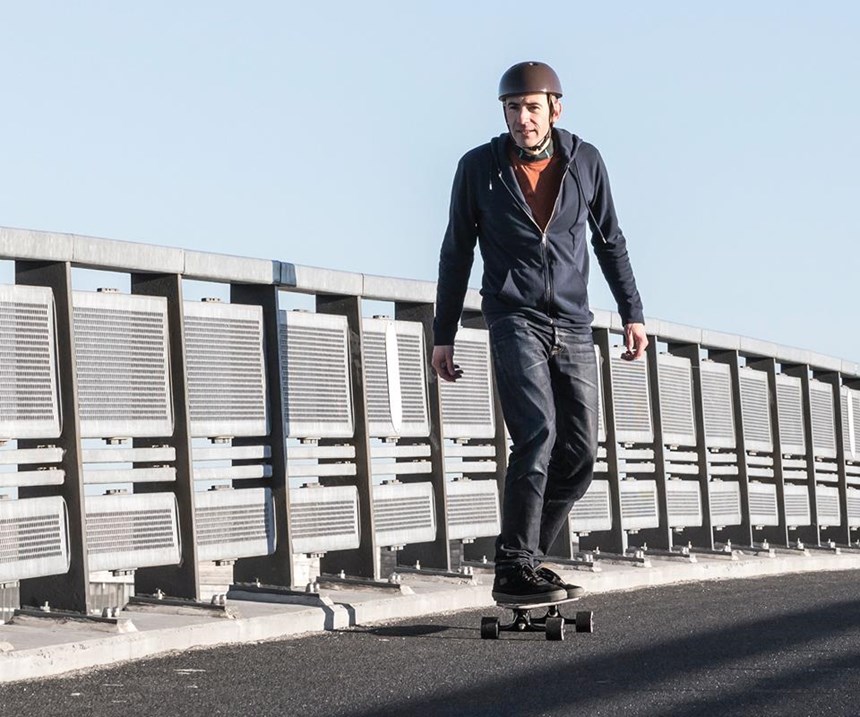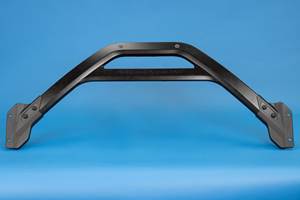Software shortens design path to longboard
Materials information program helps optimize materials selection.
When FORCE Technology (Brøndby, Denmark), a technology consultancy to the energy, oil and gas, maritime and manufacturing markets, wanted to teach its staff about composites, the challenge was how best to do it. To communicate which materials to use and how they should be combined to optimize their performance, composites specialist Benjamin Hornblow (on longboard in above photo) had his staff design a demonstration composite “longboard” skateboard. He turned for help to Granta Design (Cambridge, UK), a materials information technology firm founded 20 years ago as a spinoff from Cambridge University’s engineering department.
Hornblow employed Granta’s 2017 CES Selector software tool to quickly identify candidate materials and evaluate ways in which they could be combined to optimize results. The first step was to investigate materials currently used in longboards and compare their performance. Although typical longboards feature maple, bamboo or composites, a state-of-the-art board, comprising a sandwich panel of carbon fiber on the bottom, maple in the core and glass fiber on the top, was used as a reference. The next step was to consider the performance of reinforcing fibers, the board’s main structural component. With Granta’s MaterialUniverse data product, the performance of five natural fibers — cotton, flax, hemp, jute and kenaf — was quickly compared/ contrasted with glass fiber, carbon fiber and aramid fiber.
Within CES Selector, Hornblow and sta could plot Young’s modulus and see that flax fibers lie within the same stiffness range as glass, but that both fall far below carbon fiber. Although natural fibers couldn’t compete with carbon or glass when tensile strength was plotted, their performance was deemed acceptable because longboard designs are stiffness-driven. When the fibers’ mechanical loss coefficients were compared, it was clear that the damping capability of flax fiber was three orders of magnitude greater than that of either glass or carbon fiber.
Hornblow then proposed a combination of carbon and flax fibers in a longboard to benefit from the stiffness of the former and damping properties of the latter. CES Selector’s Synthesizer Tool enabled him and his team to model the performance of the reference board and theoretical boards. Graphs were created in Selector to compare flexural modulus with density, using a performance index, so the team could easily identify materials that outperformed others. The CES graphs showed that a longboard made from a solid flax fiber/epoxy composite would be outperformed by a maple board, and that the reference board would perform no better than the one built with less-expensive bamboo.
Next, the team modeled the performance of a carbon fiber/PET foam-cored sandwich panel, and determined that this could lead to a large improvement over the bamboo and composite reference boards. Based on this, carbon and flax fiber were combined in a 7-layer cored panel model within CES Selector. Ultimately, it featured a 3-layer facesheet with carbon fiber twill as the outer layer, a uni carbon fiber layer, then a layer of biaxial flax fabric, with a PET foam core. The final design plot showed a big improvement over previous iterations. The design was refined in Dassault Systèmes’ (Waltham, MA, US) CATIA 3D CAD program, then prototyped and tested. The final longboard, slightly thicker than the reference and slightly less stiff in three-point bending, was 30% lighter, providing greater acceleration and a smoother, more enjoyable ride.
Says Hornblow, “It was great to use the multilayer Synthesizer Tool in CES Selector to ‘test out’ different materials, concepts and configurations early in the design process. This saved valuable time by reducing the number of iterations required for the more labor-intensive CAD modeling and prototyping stages.” Notably, FORCE Technology is workingb with a US skateboard start-up to revise the prototype, using a higher percentage of sustainable materials.
Related Content
Novel dry tape for liquid molded composites
MTorres seeks to enable next-gen aircraft and open new markets for composites with low-cost, high-permeability tapes and versatile, high-speed production lines.
Read MoreMaterials & Processes: Composites fibers and resins
Compared to legacy materials like steel, aluminum, iron and titanium, composites are still coming of age, and only just now are being better understood by design and manufacturing engineers. However, composites’ physical properties — combined with unbeatable light weight — make them undeniably attractive.
Read MoreNovel composite technology replaces welded joints in tubular structures
The Tree Composites TC-joint replaces traditional welding in jacket foundations for offshore wind turbine generator applications, advancing the world’s quest for fast, sustainable energy deployment.
Read MoreAutomotive chassis components lighten up with composites
Composite and hybrid components reduce mass, increase functionality on electric and conventional passenger vehicles.
Read MoreRead Next
Composites end markets: Energy (2024)
Composites are used widely in oil/gas, wind and other renewable energy applications. Despite market challenges, growth potential and innovation for composites continue.
Read MoreFrom the CW Archives: The tale of the thermoplastic cryotank
In 2006, guest columnist Bob Hartunian related the story of his efforts two decades prior, while at McDonnell Douglas, to develop a thermoplastic composite crytank for hydrogen storage. He learned a lot of lessons.
Read MoreCW’s 2024 Top Shops survey offers new approach to benchmarking
Respondents that complete the survey by April 30, 2024, have the chance to be recognized as an honoree.
Read More




















.jpg;maxWidth=300;quality=90)








